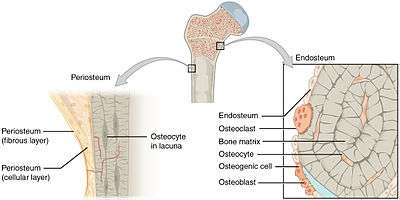Endosteum
The endosteum (plural endostea) is a thin vascular membrane of connective tissue that lines the inner surface of the bony tissue that forms the medullary cavity of long bones.[1][2]
| Endosteum | |
|---|---|
 Endosteum covers the inside of bones, and surrounds the medullary cavity. | |
| Identifiers | |
| TA | A02.0.00.038 |
| TH | H2.00.03.7.00022 |
| FMA | 32692 |
| Anatomical terminology | |
This endosteal surface is usually resorbed during long periods of malnutrition, resulting in less cortical thickness.
The outer surface of a bone is lined by a thin layer of connective tissue that is very similar in morphology and function to endosteum. It is called the periosteum, or the periosteal surface. During bone growth, the width of the bone increases as osteoblasts lay new bone tissue at the periosteum. To prevent the bone from becoming unnecessarily thick, osteoclasts resorb the bone from the endosteal side.
Additional images
 Long bone
Long bone
References
- Netter, Frank H. (1987). Musculoskeletal system: anatomy, physiology, and metabolic disorders. Summit, New Jersey: Ciba-Geigy Corporation ISBN 0-914168-88-6, p.171
- "Definition of ENDOSTEUM". www.merriam-webster.com.
External links
- Anatomy photo: Musculoskeletal/bone/structure1/structure2 - Comparative Organology at University of California, Davis - "Bone, structure (LM, High)"
- Image at dal.ca
This article is issued from
Wikipedia.
The text is licensed under Creative
Commons - Attribution - Sharealike.
Additional terms may apply for the media files.